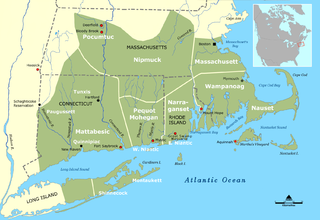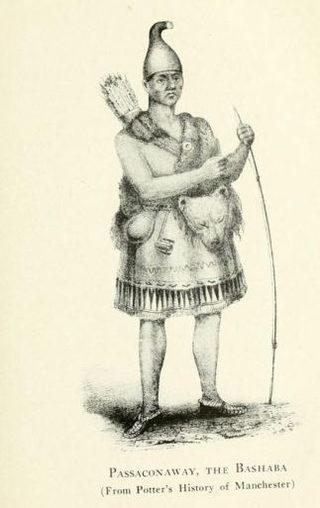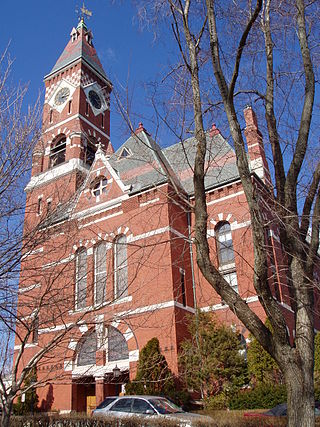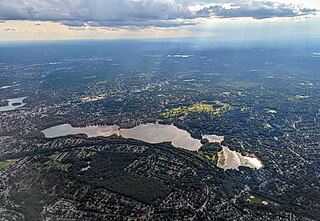Related Research Articles

Malden is a city in Middlesex County,Massachusetts,United States. At the time of the 2020 U.S. Census,the population was 66,263 people.

Medford is a city 6.7 miles (10.8 km) northwest of downtown Boston on the Mystic River in Middlesex County,Massachusetts,United States. At the time of the 2020 U.S. Census,Medford's population was 59,659. It is home to Tufts University,which has its campus on both sides of the Medford and Somerville border.

Revere is a city in Suffolk County,Massachusetts,located approximately 5 miles (8.0 km) from downtown Boston. Founded as North Chelsea in 1846,it was renamed in 1871 after Revolutionary War patriot Paul Revere. In 1914,the Town of Revere voted to become a city and was incorporated as a city with the inauguration of its first mayor on January 4,1915. At the 2020 census,the city had a population of 62,186 inhabitants.
Wonalancet (c.1619—1697) —also spelled Wannalancet and Wannalancit and probably Wanaloset and Wanalosett —was a sachem or sagamore of the Penacook Indians. He was the son of Passaconaway.

The Massachusett were a Native American tribe from the region in and around present-day Greater Boston in the Commonwealth of Massachusetts. The name comes from the Massachusett language term for "At the Great Hill," referring to the Blue Hills overlooking Boston Harbor from the south.

Passaconaway was a 17th century sachem and later bashaba of the Pennacook people in what is now southern New Hampshire in the United States,who was famous for his dealings with the Plimouth and Massachusetts Bay Colonies.
The Pennacook,also known by the names Penacook and Pennacock,were an Algonquian-speaking Indigenous peoples of the Northeastern Woodlands who lived in Massachusetts,New Hampshire,and southern Maine. They were not a united tribe but a network of politically and culturally allied communities. Penacook was also the name of a specific Native village in what is now Concord,New Hampshire.

Massachusetts's 6th congressional district is located in northeastern Massachusetts. It contains most of Essex County,including the North Shore and Cape Ann,as well as part of Middlesex County. It is represented by Seth Moulton,who has represented the district since January 2015. The shape of the district went through minor changes effective from the elections of 2012 after Massachusetts congressional redistricting to reflect the 2010 census. The towns of Tewksbury and Billerica were added,along with a small portion of the town of Andover.

Abbot Hall is a town hall and historical museum located at 188 Washington Street,Marblehead,Massachusetts. It is open year-round,though with restricted hours in the colder months. Constructed in 1876 and designed in the Romanesque style by Lord &Fuller architects,the Hall is listed on the National Register of Historic Places as a contributing property in the historic district.

Sachems and sagamores are paramount chiefs among the Algonquians or other Native American tribes of northeastern North America,including the Iroquois. The two words are anglicizations of cognate terms from different Eastern Algonquian languages. Some sources indicate the sagamore was a lesser chief elected by a single band,while the sachem was the head or representative elected by a tribe or group of bands;others suggest the two terms were interchangeable. The positions are elective,not hereditary. Although not strictly hereditary the title of Sachem is often passed through the equivalent of tanistry.

The Mystic Lakes,consisting of Upper Mystic Lake and Lower Mystic Lake,are closely linked bodies of water in the northwestern suburbs of Boston,Massachusetts.
The Pawtucket tribe were a confederation of Eastern Algonquian-speaking Native Americans in present-day northeastern Massachusetts and southeastern New Hampshire. They are mostly known in the historical record for their dealings with the early English colonists in the 17th century. Confusion exists about the proper endonym for this group who are variously referred to in European documents as Pawtucket,Pentucket,Naumkeag,Wamesit,or Mystic Indians,or by the name of their current sachem or sagamore.

Naumkeag is a historical tribe of Eastern Algonquian-speaking Native American people who lived in northeastern Massachusetts. They controlled most of the territory from the Charles River to the Merrimack River at the time of the Puritan migration to New England (1620–1640).
The Spirit of Adventure Council is a regional council of the Boy Scouts of America. It serves the greater Boston,Massachusetts,area.
Masconomet,spelled many different ways in colonial deeds,was sagamore of the Agawam tribe among the Algonquian peoples during the time of the English colonization of the Americas. He is known for his quitclaim deed ceding all the tribal land,which extended from Cape Ann to the Merrimack River,as far inland as North Andover,Massachusetts and Middleton,Massachusetts,and as far to the southwest as the Danvers River,to John Winthrop the Younger,his heirs and all the settlers of eastern Essex County for a sum of 20 pounds,about 100 dollars.

Chickatawbut was the sachem,or leader,of a large group of indigenous people known as the Massachusett tribe in what is now eastern Massachusetts,United States,during the initial period of English settlement in the region in the early seventeenth century.
Montowampate (1609–1633),was the Sachem of the Naumkeag or Pawtucket in the area of present day Saugus,Massachusetts at the time of the Puritan Great Migration. The colonists called him Sagamore James. He was one of three sons of Nanepashemet,the sachem of the entire region occupied by tribes of the confederation.
Wenepoykin (1616–1684) also known as Winnepurkett,Sagamore George,George No Nose,and George Rumney Marsh was a Native American leader who was the Sachem of the Naumkeag people when English began to settle in the area.

Wonohaquaham also known as Sagamore John was a Native American leader who was a Pawtucket Confederation Sachem when English began to settle in the area.

Squaw Sachem of Mistick was a prominent leader of a Massachusett tribe who deeded large tracts of land in eastern Massachusetts to early colonial settlers.
References
- ↑ Stewart-Smith, D. (2002). "The Pennacook Lands and Relations: Family Homelands." In Piotrowski, Thaddeus M. (2002). The Indian Heritage of New Hampshire and Northern New England. Jefferson, NC: McFarland. p. 123. ISBN 9780786410989 . Retrieved 2009-08-04.
- ↑ Williams, Roger (1827). A Key into the Language of America. Providence: John Miller. p. 110. Retrieved 2008-12-11. Reprint of a book first published in 1643.
- ↑ Thatcher, Benjamin Bussey (1839). Indian Biography: Or, An Historical ... Vol. II. New York: Harper & Brothers. p. 9. Retrieved 2009-08-04.
- 1 2 William Bradford, Edward Winslow (1865). Mourt's Relation, or Journal of the Plantation at Plymouth. Boston: J. K. Wiggin. Retrieved 2008-12-23. Reprint of the original version.
- ↑ Hurd, Duane Hamilton (1890). History of Middlesex County, Massachusetts, Volume 1. Philadelphia: J. W. Lewis. Retrieved 2010-02-25.
- ↑ "Charlestown". Boston Women's Heritage Trail.
- 1 2 Brooks, Charles (1886). History of the Town of Medford, Middlesex County, Massachusetts. Rand, Avery. Retrieved 2010-02-25.
- ↑ Winthrop, John (1996). The Journal of John Winthrop, 1630-1649 . Harvard University Press. Retrieved 2010-02-25. Reprint of the original text.
- ↑ Winthrop, John (1908). Winthrop's Journal: "History of New England", 1630-1649. Scribner's.
- 1 2 Perley, Sidney (1912). The Indian Land Titles of Essex County, Massachusetts. Salem: Essex Book and Print Club. Retrieved 2008-12-11.
- ↑ "Bedrock Geology of the Middlesex Fells Reservation, MassachusettsThe Geology of the Middlesex Fells" . Retrieved 2023-06-03.
- ↑ "Hills of Stoneham, Mass. | Hills of the Boston Basin". bostonbasinhills.org. Retrieved 2023-06-03.